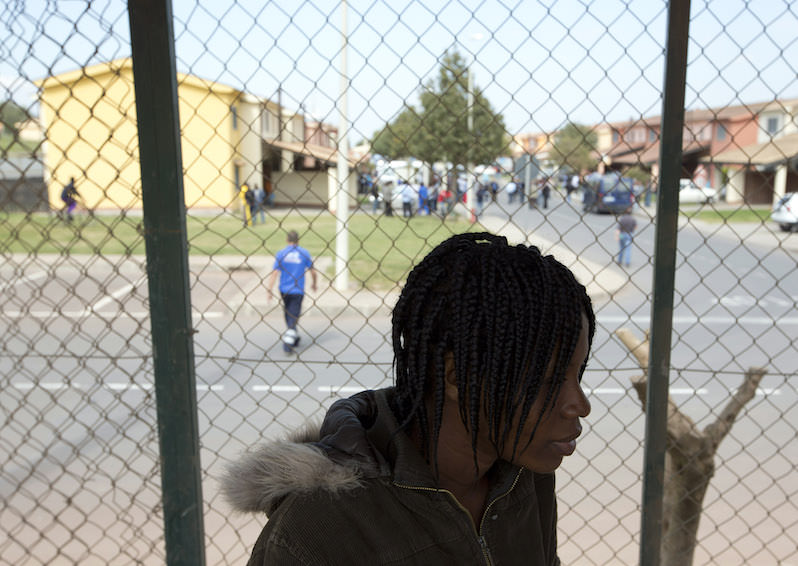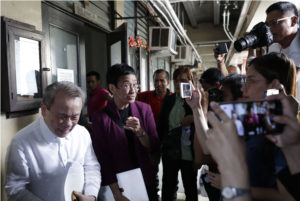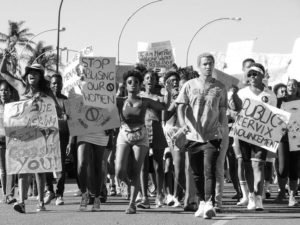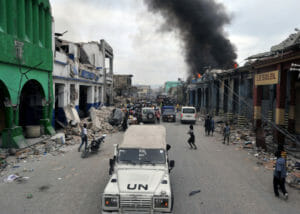Women Seeking Refuge: a Crisis Within a Crisis
Sexual violence is part of the price many women and girls fleeing their countries for Europe must pay. This crisis—notably dire for Africans—can be mitigated if refugee aid agencies give priority to specific female-centered measures.
Silla Zelia, a 23-year-old asylum seeker from Ivory Coast, at an immigration center in Mineo, Sicily, in 2015. (Alessandra Tarantino / AP)
With Mount Etna looming in the distance, Catania boasts some of the most beautiful beaches in Italy. In summer, the city draws crowds of tourists, most of whom are unaware that in this season, 2,000 refugees are landing daily on nearby shores. Sixty percent of those arriving in Europe during the first five months of 2016 were women and children, many fleeing physical and sexual violence in their countries — only to encounter worse on their journeys.
In June, I was part of a refugee mission to Catania that included members of the Society of Black Lawyers (UK), the Association of Muslim Lawyers (UK), the international Coalition Against Trafficking in Women, and Association IROKO (Italy). Several of us made the trip to investigate the specific situation of women in the migration/refugee* [see footnote] process. We were keenly aware of how violence against women is subsumed in the generic crimes of this humanitarian crisis, and we were also aware of the invisibility of female refugees in the media.
Well known for its earthquakes, Catania is facing a different kind of upheaval, receiving two-thirds of all migrants arriving in Italy. The city has established the largest refugee camp in Europe in the nearby town of Mineo. Depending on the month, Mineo houses 3,000 to 4,000 refugees in residential structures formerly used by the U.S. Army and designed to shelter only 2,000. At the time we visited Mineo, residents included a mix of Eritreans, Nigerians, Ghanaians, Gambians, Moroccans and Bangladeshis. Twenty percent of the residents were female.
Entry to the camp was not easy, and it took the intervention of the mayor’s office in Catania to receive authorization. As we drove the long and winding country route out of the city, the landscape signaled isolation until the Mineo camp rose from the fields. Our initial view from a distance was of a seemingly idyllic sanctuary of yellow and pink buildings. As we got closer, we saw a 10- or 12-foot fence topped with barbed wire. Armed soldiers carrying automatic weapons guarded the entrance and patrolled the perimeter.
We waited a long time before being allowed in. I thought of the months and years that refugees wait for their papers, with the average time lag for asylum petitions reported to be 18 months. When the camp director finally gave us an informational tour of the center and answered our questions, I asked about services in the camps. The director listed legal aid, medical care, psychological counseling, Italian language courses, computer classes and job training. After speaking with staff members, I felt they were doing an impressive job in very difficult and crowded circumstances.
Media articles, however, spoke of migrants feeling stranded in the middle of nowhere with nothing to do as they wait, seemingly interminably, for their papers. Residents sleep in overcrowded rooms, sometimes with six to eight people and often lacking ventilation. Camp migrants who work in the local area’s lemon and orange groves report their earnings as 15 euros (about $17) a day.
In 2014, investigators uncovered a vast corruption scheme at Mineo. Organized crime groups had infiltrated the camp’s administration, and authorities arrested a local mafia leader. When I asked the director about reported occurrences of trafficking in the camps, he said that in the past there had been several cases that may have involved people from the camp but that camp management worked with police to prevent future incidents.
Near the camp, however, is a blatant prostitution arcade that lines the country roads leading to Mineo. Scantily clad African women stand or sit in expected postures that attract male prostitution users. Any astute observer who has visited Italy in the last 15 years has seen African women who are obviously in prostitution along rural, highway and trucking routes. I had witnessed this wretched scene each time I traveled to Italy in the past, but I had never beheld hundreds of women prostituting every quarter-mile, as if in a vast, sprawling brothel operating en plein air.
In Catania, I spoke with Efosa (a pseudonym), a male migrant from Nigeria, and asked if he had knowledge of Nigerian women being trafficked for prostitution into Italy. He told me:
Yes, they bring them here on the boats for prostitution. … They tell the girls, “I will carry you to Italy. Would you like to go? I will take care of everything. You will pay me back.” But these girls suffer. They take their money, they beat them, they abuse them. I see them every night on the streets near the railroad station. Men stop their cars and use them. Before bringing them, the traffickers make them swear oaths. They remove a piece of their hair. They tell them, “It’s secret. If you tell anyone, you will die.”
Efosa reinforced what Dr. Esohe Aghatise, director of Association IROKO, has revealed in her work with Nigerian prostituted women. She writes that 80 percent of these women and girls trafficked into Europe come from the Edo state and are held in a vise of psychological indenture. The traffickers subject the women to magic juju rituals in which they are compelled to take blood vows and promise to pay off their debts of passage by engaging in prostitution. Such rites generate a multitude of threats and fears, as well as “an exaggerated sense of obligation to their perceived benefactors,” who exact promises from them never to reveal the identity of their traffickers.For women, the entire journey from Africa to Italy is abysmal. They encounter sexual violence all along the way from drivers, border guards, police, smugglers, traffickers, fellow migrants, and staff in refugee centers and camps. In Mineo, we spoke with six Nigerian women refugees who had traveled to Libya to board the perilous boats to Italy. Initially, they were hesitant to talk, but then all began to speak at once in a cacophony of conviction about their experiences. All six of these women had been raped during her passage.
I had already heard from Efosa, the Nigerian male I met in Catania, that the smuggler who transported Efosa’s group of migrants across the desert had forced all the women and girls at various points in the crossing to exit the van, where he abused and raped them. When I asked if the men in the van had tried to stop the rapes, he showed me an obviously fractured arm, its condition worsened by lack of medical treatment: “This is what they did to me.” The smugglers had weapons, and “no one could stop them.”
The dedicated doctor who staffs the Mineo medical clinic confirmed that the majority of women she treats are victims of “sexual violence.” Since 2012, she has seen an increase in sexual violence, particularly in women arriving on the sea route from Libya. Many of the women she takes care of had made the crossing unaccompanied, having no other choice. Some arrive HIV-positive or with other sexually transmitted infections. Others arrive pregnant, the result of rape during the journey.
The worst punishment the Nigerian women could imagine was to be sent back to Libya. All the Nigerians I interviewed had nothing good to say about the Libyans they encountered: “They hate black people. They say we women are all prostitutes. They ask if you are Christian or Muslim. If you say Christian, they beat you and put you in prison. If you say Muslim, they ask you to recite a prayer. If you can’t, they beat you and put you in prison.” Another said the hospitals would not treat black people. A third woman, who had miscarried, said, “They beat you even when you are pregnant.” She had witnessed the scene of a man traveling with two women, perhaps one his wife and the other his sister. “The Libyans beat the man, raped the women, and then at gunpoint forced the man to have sex with both women.” Much of this abuse is fueled by the raging anarchy in Libya, where institutional protections are tragically lacking.
The sea routes tacitly reinforce a racist picture of the refugee crisis. A recent New York Times article was headlined, “For Europe, Arab Lives Matter More Than Africans’.” Africans take the Libyan sea route, paying $1,000 to $2,000 to smugglers who pile them into cheap rubber dinghies vulnerable to capsizing. Another major sea route, from Egypt to Italy, is called “the business class” route. It is used by Syrian refugees who pay $3,000 to $5,000 for passage on relatively more seaworthy wooden boats.
In 2016, the largest number of migrants arriving in Italy has been Eritreans; the second-largest, Nigerians. Most Africans are economic migrants whose desperate financial conditions generally do not qualify them for refugee status or other forms of protection. Fleeing from conflict, Syrians, Iraqis and Afghanis have a well-founded and legally recognized fear of persecution in their own countries. Yet the Africans, who have also suffered rape, beatings, torture and imprisonment in Libya or on the seas, are not legally recognized refugees because they were not subjected to these torments in their countries of origin.
NGOs and United Nations agencies have put forth a number of specific recommendations responding to the situation of refugee women. Before anything else, countries must be willing to acknowledge that the current surge of women seeking refuge is a crisis within a crisis. The prosecutor’s office at the Palace of Justice in Catania is making an aggressive effort to take legal action against traffickers so that women have effective access to justice.
As many experts on refugee women have pointed out, there are solutions that can help mitigate the emergency, if woman-centered assistance is given at the camp level. Relief includes more female interpreters and reception center staffers, separate accommodations for women, separate sanitation facilities, monitoring for sexual predators, and access to child care, medical care and voluntary counseling for sexual trauma. Basic necessities like sanitary pads are often absent from provided items. Women can be pushed aside from food lines or end up being the last to receive care packages.
One of the bright spots of our mission was visiting the local coast guard at the Port of Catania. We were allowed to board the boat in port, and the commander gave us a tour explaining how they conduct the many searches and rescues that have saved thousands of refugee lives. In 2015, the Italian Coast Guard responded to more than 8,000 emergency calls of distress.
In the last two years, Italy has rescued more migrants than in the previous 23. This weathered city of Catania is doing more than most and is trying to provide for the particular needs of female refugees. Almost all residents I talked with were sympathetic to the migrants’ plight. When we asked the Coast Guard commander how he continues to do such work, day after day, in the most dangerous of seas and with many refugees dying on the way, he responded: “It’s work that pays you back.”
Would that this sentiment could breach the global anti-immigration movements.
—
* I use the words “migrant” and “refugee” interchangeably. “Refugee” is a legal term as well as a term that describes those seeking refuge. Migrants fleeing conflict are generally qualified as legal refugees, whereas migrants escaping economic desperation are not acknowledged as refugees by the 1951 U.N. Convention on Refugees. Nonetheless in my rendering, fleeing one’s home and country for any well-founded fear is the state of being a refugee.
Janice G. Raymond is professor emerita of women’s studies and medical ethics at the University of Massachusetts, Amherst. She is the former co-executive director of the Coalition Against Trafficking in Women and has written extensively on sex trafficking, prostitution and the global sex industry.
Independent journalism is under threat and overshadowed by heavily funded mainstream media.
You can help level the playing field. Become a member.
Your tax-deductible contribution keeps us digging beneath the headlines to give you thought-provoking, investigative reporting and analysis that unearths what's really happening- without compromise.
Give today to support our courageous, independent journalists.






You need to be a supporter to comment.
There are currently no responses to this article.
Be the first to respond.